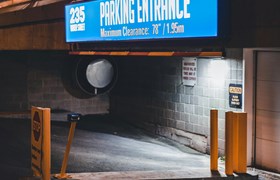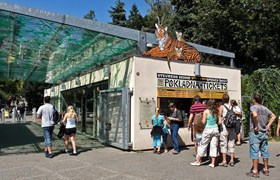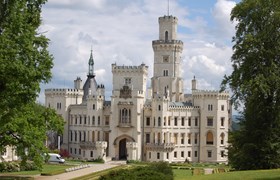What to go in Czech Republic?
Karlštejn (Karlštejn), located in 40 km from Prague
It is one of the most famous medieval cultural and historical monuments. It was built in 1348 by Charles IV, the Czech King and the Emperor of Holy Roman Empire. The castle was intended to become the Imperial residence and "box" to store the crown jewels and valuable relics of the Roman Empire (and later the Czech Treasure, too).
Karlovy Vary (Karlovy Vary), located in 130 km from Prague
The largest resort of the Czech Republic. It is famous since the time of Charles IV. Tthere are 12 soil springs in the city, warm and hot. In Karlovy Vary there is the largest Golf course in the Czech Republic.
Hluboka nad Vltavou (Hluboká n. Vlt.)located in 150 km from Prague
It is one of the most beautiful and most visited castles in the Czech Republic. The original Royal castle was reconstructed in Renaissance style and in the 19th century acquired today's pseudo-Gothic form. Near this castle lays luxurious English Park with Baroque Hunting castle of Obora, which houses the Museum of hunting and forestry.
Cesky Krumlov (Český Krumlov) located in 170 km from Prague
In 1992 the Urban architectural nature reserve is included in the list of UNESCO world cultural and natural heritage. Most prominent of it is the castle, the second largest castle in Bohemia after that in Prague. Moreover in the castle you can see a gallery of valuable paintings, also there you can attend a theatrical performance in a natural amphitheater, with a unique revolving auditorium.
Telc (Telč) located in 160 km from Prague
Telč is a unique urban and architectural natural reserve. Here is a number of outstanding architectural monuments – Renaissance castle and houses built in Renaissance and Baroque styles, which constitute the historical center of the city. This city is a unique monument in Europe and is recorded as UNESCO world heritage (UNESCO World Heritage Record).

Kutná Hora (Kutná Hora) located in 60 km from Prague
The history of Kutna Hora is connected with the extraction of silver ore on its territory. In the middle ages uo to the 14th century, silver mining in this district was approximately one-third of silver production in Europe. Production started in the second half of the 13th century, but already in the 10th century, near the ancient settlement of Malin, the famous residence of kind family Slavnikova, silver dinars were stamped, a raw material which was based on the superficial layers of silver ore not far from the city.
Castle Lednice (Zámek Lednice) located in 260 km from Prague
The Lednice castle is located in the eponymous village on the right Bank of the river Thaya, approximately 12 km South-East of Mikulova. Castle with a large Park is one of the most beautiful complexes in the Czech Republic. The Lednice estate was acquired by family Liechtenstein in 1249 was owned by it for nearly 700 years.
Valtice (Valtice) 260 km from Prague
Valtice is a town located near the Austrian border, it is famous for a beautiful castle and winemaking. Valtice castle was a luxurious residence of the Austrian and Moravian lords of Lichtenstein family. It was famed not only for its beauty but also its art: the Palace theatre competed in those times in the full sense of the word with the Vienna stage.
Litomyšl castle (Zámek Litomyšl) 150 km from Prague
Litomyšl is a small town located in Pardubice region, 18 km Northwest from Svitov. The area of the castle of Renaissance period 1568 – 1581 is recorded in the world cultural heritage list of UNESCO, Litomyšl became one of themost visited tourist places in the Czech Republic because of its attractiveness
Zdar on Sázavou (Žďár nad Sázavou) located in 140 km from Prague
Zdar on Sazavou is a district town, lying on the border of Bohemia and Moravia in a picturesque Ceskomoravska region in the middle of the protected area Zdarske hills. Its history is closely connected with the development of Darskogo Cistercian Monastery and rises up to the half of the 13th century. Town of Zdar took the status of a town in 1607 by order of cardinal Frantisek of the Dietrichsteins. Today's appearance of the former monastery is a result of major renovations of the Abbot Václav Vejmluvy in the first half 18 for nearly a century. The reconstruction was designed by the architect Jan Jan Blažej Santini Aichel.

The complex of Kroměříž (Zámek a zahrady Kroměříž) located in 270 km from Prague
The complex of parks and castles in Kroměříž was included in 1995 in the list of National cultural monuments of the Czech Republic, and in December 1998 was recorded in the world cultural heritage list of UNESCO. This demonstrates the responsible attitude of the residents towards the heritage and monuments created not only for the present but for the future.
Monument Terezín (Terezín) located in 70 km from Prague
The Terezín monument appeared in the place of torment of thousands of people. It is considered as a national monument since 1947 on the initiative of the government of the renewed Czechoslovak Republic. In the Czech Republic it is the only monument of this kind. Its purpose is to preserve the memory of the victims of racial and political persecution during the Nazi occupation and the death of thousands of people.
Křivoklát (Křivoklát) located in 50 km from Prague
Křivoklát is one of the oldest castles of the Czech princes and kings of XI century. During the reign of Premysl Otakar II a magnificent Royal castle appeared, which was rebuilt by Václav IV and later almost entirely rebuilt in the times of Wladyslaw the Jagiellonian and his successor Ludwig in 1493-1522. In the XIX century there was the restoration of the fortress, after which the castle took on the form, preserved until today.

Konopiště (Konopiště) located in 45 km from Prague
Konopiště castle is perhaps the most beautiful of all castles, located in the Middle Czechia. Originally it was a medieval fortress with seven towers, two drawbridges and strong fortification walls, it was built according to the model of French cathedrals in the late 13th century by Bishop Tobiason of Benešov. For centuries the castle was repeatedly rebuilt and changed its owners. The most famous owner was the heir to the Austro-Hungarian throne Franz Ferdinand D'Este, Archduke and heir to the Habsburg throne. In 1914 he was killed in Sarajevo by members of the conspiratorial group “Young Bosnia", that was the pretext for the outbreak of the First World war.
Popular Articles

Be prepared to travel abroad
Be prepared to travel abroad What can expect a person, travelling by car, beyond the borders of the Czech RepublicEach state has its own road traffic regulations, which may slightly differ. The knowle

Toll roads in the Czech Republic
Toll roads in the Czech Republic: what do you need to know? The practice of toll roads is not new to the European Union, but each country has its own rules and features, and the Czech Republic is no e

Where to Stay in Prague?
Magnificent Prague: where is the best place for tourists to stay The Czech Republic is a magnificent European country with impressive architecture, a huge number of attractions, incredibly beautiful p















